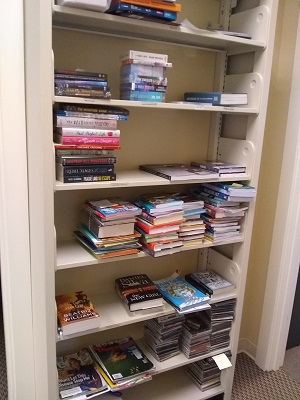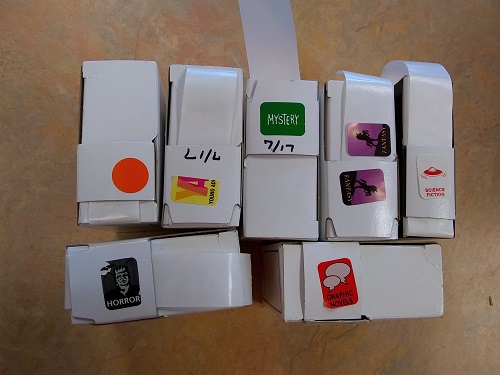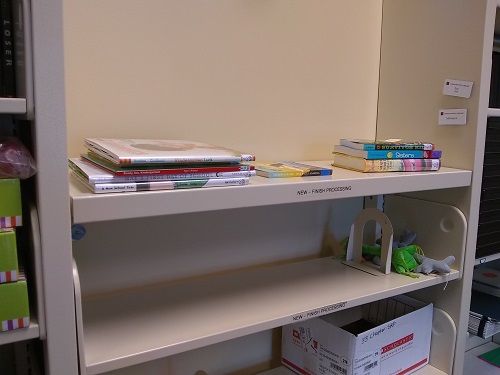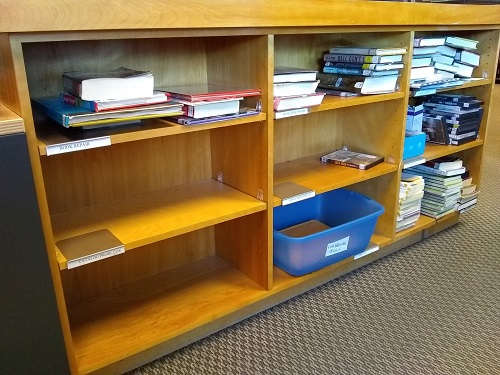 We are a library. Books are our business. (Certainly not our only business, but quite a bit of what we do centers around books.) Have you wondered about the life of a book at Topsham Public Library? How do we decide what titles to buy? What happens after we order the books? What happens if a book is damaged? And how do we decide to withdraw a title? You can find the answers below as I walk you through the life of a book at Topsham Public Library.
We are a library. Books are our business. (Certainly not our only business, but quite a bit of what we do centers around books.) Have you wondered about the life of a book at Topsham Public Library? How do we decide what titles to buy? What happens after we order the books? What happens if a book is damaged? And how do we decide to withdraw a title? You can find the answers below as I walk you through the life of a book at Topsham Public Library.
There are three different staff members responsible for ordering our titles. Emma, Adult Services Librarian, orders for the adults, Cyndi, Teen Services Librarian, orders for the teens and Mariah, Children’s Librarian, orders for the children’s department. The decision to buy certain titles is based on a number of factors: what titles have a long wait list in the inter-library loan service, a look at a variety of top 10 lists like the New York Times Bestseller List, what titles people are talking about, what review materials like Kirkus are saying, what is heard in the media from sources such as NPR, and what our own library trends are, for example, at Topsham Public Library books written by Paul Doiron are automatic, no-brainer orders. And you, our patron, may certainly request an item be added to the collection.
After the orders are placed, we wait for the UPS delivery. If you are in the staff room, you might hear someone exclaim, “UPS is here!” as the big brown truck pulls up to our door. And then we all seem to find something that needs to be done at the back desk trying to peak over the shoulder of the lucky one unpacking the box. (Then the race is on to request that new title that piques our interest. FYI – Helen has the quickest fingers in the building.) As the books are unpacked, each item is checked for damage or missing pages, and checked to see if the cover has the protective plastic cover already on it.
 The books that don’t pass inspection are sent back to the publisher. The books that pass the inspection, and most of them do, are placed on the processing shelves. Each department has their own section. For example, YA books go on the YA section of the shelf, audio books go on the audio book section, etc, etc. The books wait there to be cataloged.
The books that don’t pass inspection are sent back to the publisher. The books that pass the inspection, and most of them do, are placed on the processing shelves. Each department has their own section. For example, YA books go on the YA section of the shelf, audio books go on the audio book section, etc, etc. The books wait there to be cataloged.
Helen and Lynne are the cataloging experts and are tasked with cataloging the hundreds of items that we receive each month. DVDs, music CDs, books, audio books, graphic novels, magazines, large print, children’s books, young adult books, and non-fiction books – all of them need to be cataloged.
Cataloging is a system by which we can find the item you are looking for. There is a record that exists for each item. Helen and Lynne must find that record and examine it to make sure that the item we have matches it exactly. If it matches exactly – no problem. If it doesn’t match it exactly, then a record must be found or created. Why does it matter? If you are looking for the fifth edition of a title, you don’t want the fourth edition. If you don’t have a blue-ray player, you don’t want a movie on a blu-ray disc. The details matter when you want a specific item and cataloging ensures you find the specific item you want.
 Lynne and Helen assign a barcode to each item and affix the spine label to the item. The barcode is what is scanned when you check out a book and it is how we keep track of the book. The spine label is what staff and volunteers use to shelve the item. You may also notice other labels on the spine. Those labels are to help you. The most used label is the orange dot you will see just above the spine label and that orange dot signifies it is a large print book. There are also labels that say Graphic Novel, or YA for Young Adult, or Mystery, or Horror, or Fantasy, etc. Those labels are to help you find something you might be interested in. Looking for a new mystery writer? Look for the mystery label. Looking for something to scare your socks off? Look for the Horror label. (Of course, you may always ask staff for a suggestion, but sometimes you just want to browse and the labels are there to help.)
Lynne and Helen assign a barcode to each item and affix the spine label to the item. The barcode is what is scanned when you check out a book and it is how we keep track of the book. The spine label is what staff and volunteers use to shelve the item. You may also notice other labels on the spine. Those labels are to help you. The most used label is the orange dot you will see just above the spine label and that orange dot signifies it is a large print book. There are also labels that say Graphic Novel, or YA for Young Adult, or Mystery, or Horror, or Fantasy, etc. Those labels are to help you find something you might be interested in. Looking for a new mystery writer? Look for the mystery label. Looking for something to scare your socks off? Look for the Horror label. (Of course, you may always ask staff for a suggestion, but sometimes you just want to browse and the labels are there to help.)
 Once the item is cataloged, it is put on the “In Processing” shelf. Any staff member is able to finish the processing of books. The date slips are placed in the front of a book. These are the slips on which we stamp the due date. Staff also stamps “Topsham Public Library” on the first end page and on the title page which helps identify it as one of our books. If it is a new item, we stamp the month and year on the first end page so we know to display it in the appropriate “New Items” sections throughout the library. Also, if a book was delivered that did not have that protective plastic cover, staff would add it at this time.
Once the item is cataloged, it is put on the “In Processing” shelf. Any staff member is able to finish the processing of books. The date slips are placed in the front of a book. These are the slips on which we stamp the due date. Staff also stamps “Topsham Public Library” on the first end page and on the title page which helps identify it as one of our books. If it is a new item, we stamp the month and year on the first end page so we know to display it in the appropriate “New Items” sections throughout the library. Also, if a book was delivered that did not have that protective plastic cover, staff would add it at this time.
Sometimes a book gets damaged. It will happen inevitably. It happens to us all. One day, you come to Topsham Public Library and you check out a book and take it home. Once you get that book home, your morning coffee or after dinner wine might get spilled on it. Or Fido your lovely dog decides that book is a chew toy. Or the kids get in a tug-of-war over who gets to read it. Or it gets left out in the rain, or dropped in the pool, or ends up on the floor of the van and the kids in snow covered boots tromp all over it on their way to their car seat. We understand, it happens. Bring it in. Let us know at the desk, and we will let you know what the replacement cost is. If need be, we can work something out to help you repay the amount. Please, do not buy a replacement and bring it in. We have procedures in place when something like this happens and an item needs to be paid for. If the book belongs to another library, the procedure for paying for it is different, so if that occurs we will let you know how that needs to be handled. Once it has been paid for, the item is yours.
 As each item is returned, whether through the outside drop box or the inside drop slot or through inter-library loan, the staff checks them for any damage. If we notice a ripped page, a broken spine, or a broken disc case, we mark it in the system and put it “In Repair”. If a movie or audio book is skipping, we rely on you, our patron, to let us know when you drop off the item. Please, do not try and clean an audio disc or a movie DVD yourself. Sometimes that might cause more damage than actually fix the disc. When we know the disc is skipping we place that “In Repair” as well. Once the item is noted as “In Repair” in the system, we place it on Julie’s island in the staff room. This is where Julie works her magic. Julie buffs discs, tapes pages with special tape, and fixes bindings with special glues. Once an item is fixed, the “In Repair” status is cleared and the item is placed back in circulation.
As each item is returned, whether through the outside drop box or the inside drop slot or through inter-library loan, the staff checks them for any damage. If we notice a ripped page, a broken spine, or a broken disc case, we mark it in the system and put it “In Repair”. If a movie or audio book is skipping, we rely on you, our patron, to let us know when you drop off the item. Please, do not try and clean an audio disc or a movie DVD yourself. Sometimes that might cause more damage than actually fix the disc. When we know the disc is skipping we place that “In Repair” as well. Once the item is noted as “In Repair” in the system, we place it on Julie’s island in the staff room. This is where Julie works her magic. Julie buffs discs, tapes pages with special tape, and fixes bindings with special glues. Once an item is fixed, the “In Repair” status is cleared and the item is placed back in circulation.
There does come a day in every book’s life when the decision must be made whether to keep it or whether to get rid of it. Sometimes the decision is easy due to its condition. It might be damaged beyond repair, or it might be so old that the pages keep falling out or the binding is not worth repairing. Sometimes the decision is more difficult. Due to space issues, Topsham Public Library does not have enough room to house every single book. Every year, the appropriate staff look through their department looking for titles to withdraw in order to make room for new titles. It can be difficult, but if a book hasn’t been checked out in years it may be withdrawn. In the case of non-fiction if the information is out of date – like what might be found in medical books – those items will be withdrawn as well. As library staff, it’s always difficult to get rid of books, but it is a reality.
That is the life of a book from ordering to check out to withdrawal. We take seriously the care and upkeep of the items as we are mindful that the resources to purchase these items are entrusted to us.
